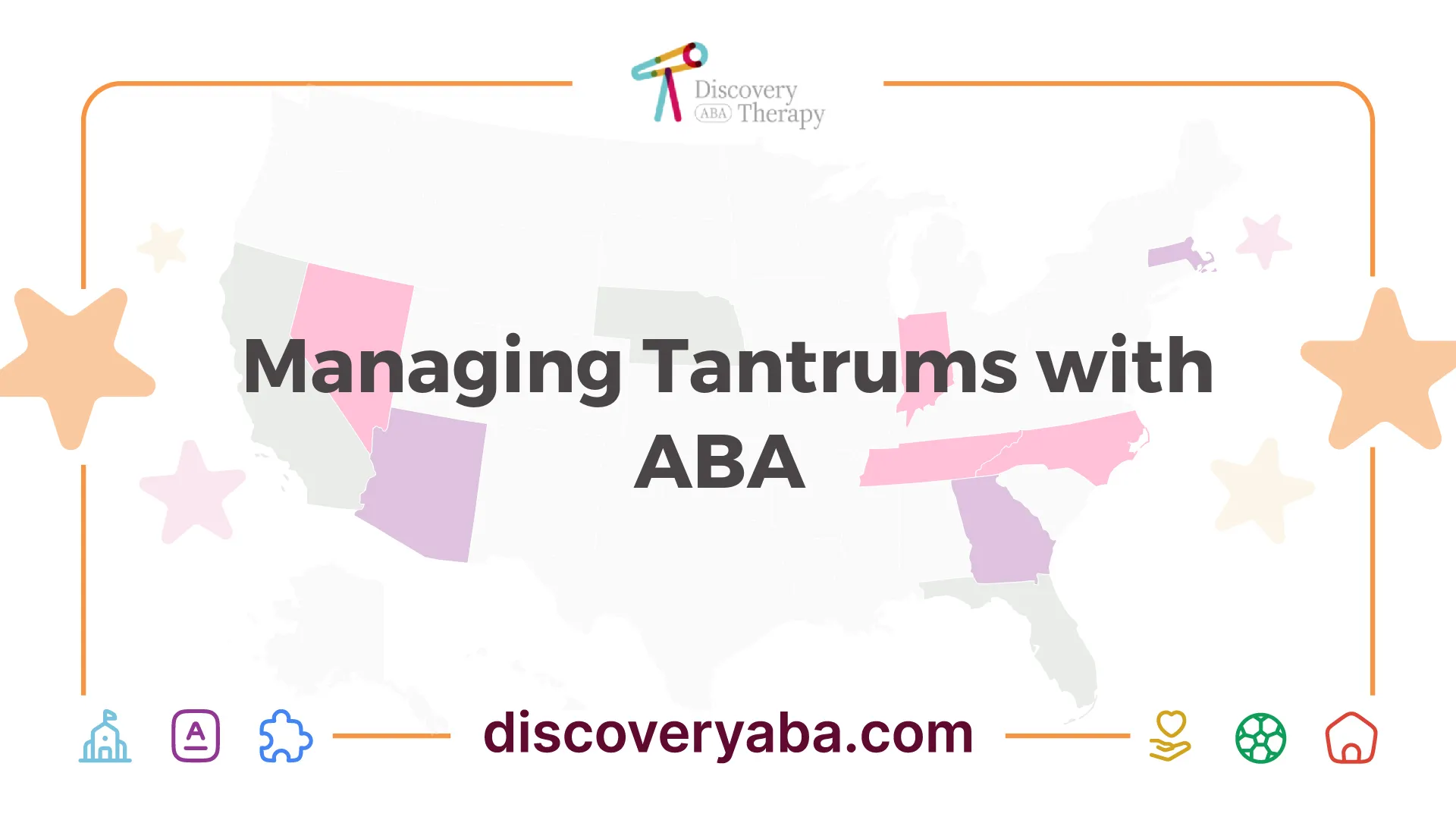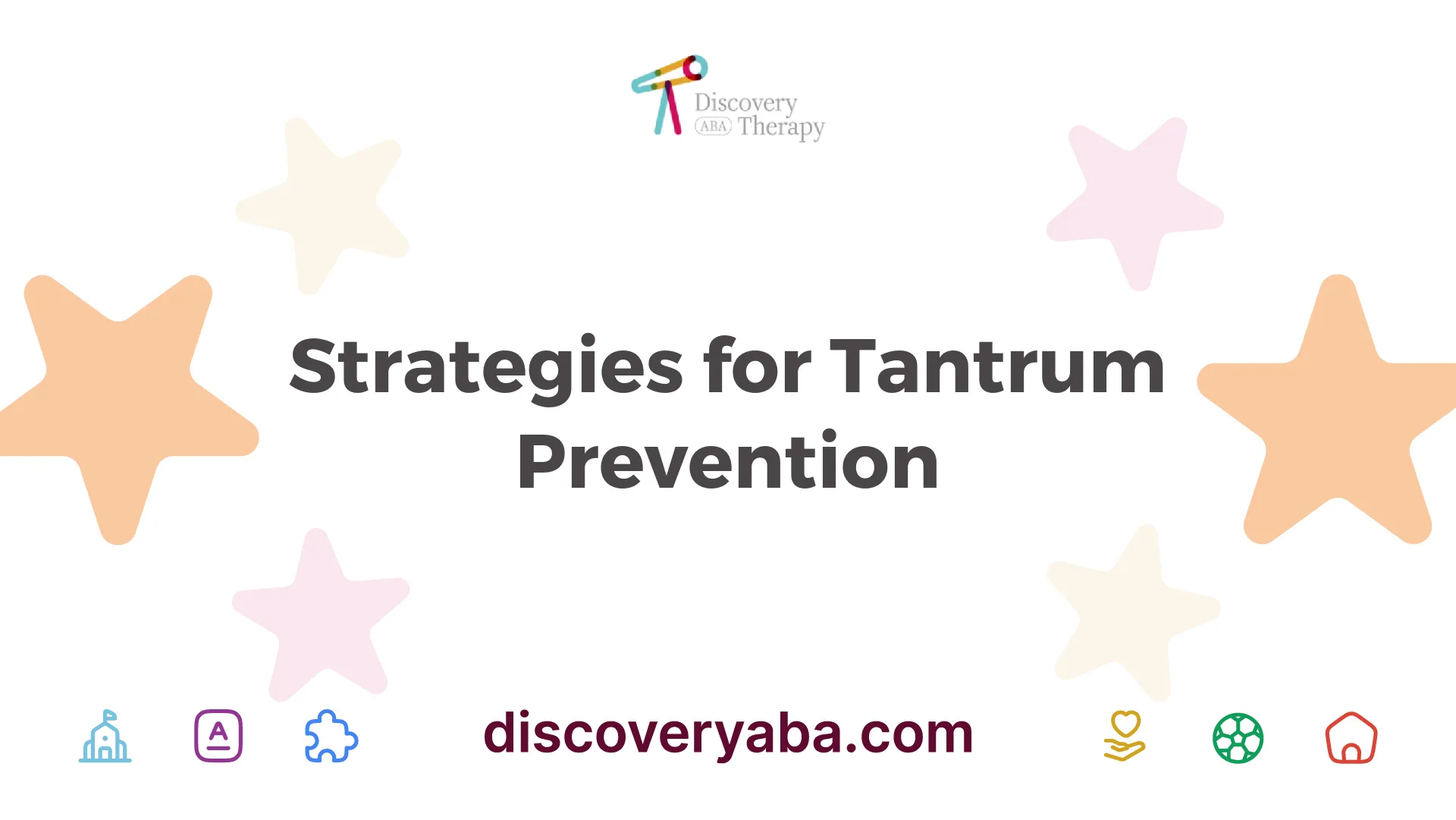Managing Tantrums with ABA
Learn effective strategies for managing tantrums with ABA, helping children with autism thrive every day.

Understanding Tantrums in Autism
Understanding tantrums in children with autism presents unique challenges. This section explores the distinctions between tantrums and meltdowns, as well as the significance of early intervention.

Differentiating Tantrums and Meltdowns
It is vital to differentiate between tantrums and meltdowns in individuals with autism. Tantrums are typically short-lived outbursts often expressed when a child is frustrated or does not get what they want. In contrast, autistic meltdowns are usually more intense, prolonged, and difficult to manage. They can occur due to sensory overload or emotional distress experienced by the individual.
CharacteristicTantrumsMeltdownsDurationShort-livedProlongedTriggersFrustration or denial of desiresSensory overload or distressAftermathMay lead to calmnessMay leave emotional exhaustionControlUsually can be redirectedOften uncontrollable
Early Intervention Importance
Early intervention plays a critical role in addressing persistent tantrums in children with autism. It allows for timely identification and strategies tailored to the child's specific needs. Specialized therapy programs can be designed to address the root causes of the behaviors, focusing on improving communication difficulties, managing sensory sensitivities, and adapting to routine changes (Yellow Bus ABA).
Understanding the causes and triggers of tantrums is essential for effective management. Developing coping strategies can minimize the occurrence and help support the emotional health of individuals with autism. For example, individual therapy methods such as aba therapy for emotional growth can offer additional resources for parents and caregivers.
This understanding will prepare parents and caregivers for better management of situations that may arise, contributing to a healthier environment for individuals with autism.
Managing Tantrums with ABA
Applied Behavior Analysis (ABA)
Applied Behavior Analysis (ABA) is a well-established therapeutic approach that focuses on understanding and modifying behavior through systematic teaching techniques. It is particularly effective in managing tantrums in children with Autism Spectrum Disorder (ASD). ABA works by identifying the function of tantrum behaviors, which can provide insights into their triggers. By using techniques such as practical functional assessments (PFA) and skill-based treatments (SBT), caregivers can teach replacement behaviors that serve the same function as the tantrum.
For instance, if a child throws a tantrum to gain attention, ABA would focus on teaching them more appropriate ways to seek attention from caregivers. This process involves reinforcing those positive behaviors while reducing instances of tantrum behavior.
ABA Techniques for Tantrum Reduction
Several ABA techniques are effective for decreasing the frequency of tantrums. Key strategies include:
Summary Table of ABA Techniques for Tantrum Management
TechniqueDescriptionCalm ReactionsMaintain composure during tantrums to avoid escalating them.Praising Positive BehaviorsReinforce desired behaviors to encourage positive actions.Identifying AntecedentsUnderstand triggers to preemptively address tantrum behaviors.Teaching Replacement BehaviorsEquip children with alternative ways to express their needs.Consistent ImplementationApply ABA strategies in both home and school settings.
Children between the ages of 1–4 years typically experience tantrums about once per day, a trend shared by both neurotypical children and those with autism. While evidence suggests that individuals with autism may not tantrum more often than their peers, their tantrums could tend to last longer or occur more frequently in certain situations. By understanding how to effectively manage tantrums with ABA, parents and caregivers can foster a more supportive environment for children with autism.
For further insight into ABA strategies that can contribute to emotional growth, check our article on ABA therapy for emotional growth.
ABA Therapy for Tantrums
Personalized ABA Programs
Applied Behavior Analysis (ABA) therapy can be tailored to meet the specific needs of each child. This customization ensures that interventions are relevant and can evolve over time. Personalized therapy programs often include strategies based on the child's unique strengths and weaknesses. According to Yellow Bus ABA, engaging a licensed, Board-Certified Behavior Analyst (BCBA) to oversee the therapy is crucial for creating effective, individualized plans.
The focus of personalized ABA programs is to reduce tantrums by employing techniques that address the specific triggers and antecedents of each child's behavior. For example, a program might incorporate specific reinforcement strategies or structured schedules to help the child manage frustrations more effectively. When parents and caregivers participate in the process, it reinforces the child's learning environment both at home and in therapy settings.
Effectiveness of ABA Therapy
ABA therapy employs evidence-based techniques grounded in Applied Behavior Analysis, which have been shown to be effective for individuals diagnosed with autism spectrum disorder. Organizations such as Autism Speaks and the Association for Behavior Analysis International endorse these techniques as the "gold standard" of treatment for autism.
Studies indicate that 90% of children receiving intensive ABA therapy demonstrated significant gains. Notably, 47% of these children reached a level where they were indistinguishable from their peers. This highlights the long-term benefits of ABA therapy and its effectiveness across various domains, including intellectual functioning, language development, daily living skills, and social functioning (Yellow Bus ABA).
Additionally, ABA therapy helps in developing and replacing challenging behaviors like tantrums with more appropriate responses. The structured and intensive nature of the therapy is invaluable for helping children acquire new skills in a supportive and effective manner. For strategies on incorporating ABA into daily life, consider exploring topics like ABA for daily routines in autism and reducing anxiety through ABA.

Strategies for Tantrum Prevention
Preventing tantrums in individuals with autism involves understanding the factors that can lead to these emotional outbursts and employing positive strategies to manage and reduce their occurrence.
Antecedents and Triggers
Identifying antecedents and triggers is critical for effective tantrum prevention. Antecedents are events or conditions that occur before a tantrum, while triggers are specific stimuli that may provoke the behavior. Common triggers often include:
Addressing these underlying causes can significantly help in managing tantrums. It is essential to create a safe environment, minimizing triggers that contribute to overwhelming situations. This allows individuals to regain control (Yellow Bus ABA).
Trigger TypeExamplesManagement StrategiesCommunication IssuesInability to express wantsUse visual aids and clear communicationSensory SensitivitiesLoud sounds, bright lightsCreate a calm space, reduce stimuliRoutine ChangesUnexpected schedule changesPrepare in advance, provide warnings
Positive Reinforcement Techniques
Positive reinforcement techniques are fundamental in managing tantrums effectively. Praising positive behaviors and teaching individuals how to respond appropriately to challenging situations can help lessen the frequency of tantrums. Strategies include:
Applying these strategies encourages positive behavior change over time. Techniques such as priming, breaking down tasks, and rewarding small successes all play a role in minimization of tantrums (Acorn Health, AutismSTEP). For comprehensive ABA strategies, consider exploring these topics: aba for school transitions and reducing anxiety through aba.
By understanding the antecedents and employing positive reinforcement, parents and caregivers can contribute to a supportive environment that diminishes the likelihood of tantrums and supports emotional well-being.
ABA Strategies in Daily Life
Incorporating Applied Behavior Analysis (ABA) strategies into daily routines can be an effective way for parents and caregivers to manage tantrums in children with autism. Two important strategies are using structured schedules and providing transition objects and toys.
Structured Schedules
Using structured schedules helps to reduce tantrums by providing predictability and establishing a safe environment. These schedules inform children about expectations and when preferred activities will take place. Tailoring schedules to match the child's abilities reinforces a sense of accomplishment and can assist in preventing tantrums.
ComponentDescriptionPredictabilityA structured routine helps children anticipate what comes next.SafetyEstablishing a safe environment reduces anxiety associated with uncertainty.EngagementClear expectations promote active participation in activities.
It is beneficial to provide warnings before the end of favored activities and utilize visual timers to help children understand the duration of an activity. These techniques facilitate smoother transitions and can potentially prevent tantrums that may arise from abrupt changes.
Transition Objects and Toys
Transition objects or toys serve as valuable tools to ease stress during transitions for children with autism. These objects can transform transitions into special or exciting experiences, helping children prepare for upcoming changes. This preparation can significantly reduce the likelihood of tantrums during transitional moments.
FeaturesBenefitsFamiliar ItemsProvides comfort and reassurance.ExcitementMakes transitions more engaging.PreparationHelps children understand changes ahead.
By strategically incorporating these methods into daily life, parents and caregivers can create supportive environments. Alongside other ABA techniques, such as breaking down tasks, offering choices, and arranging the environment to eliminate distractions, these strategies contribute to reducing tantrums and promoting positive behavior change (AutismSTEP). For more strategies on managing transitions, consider reading about aba for managing transitions.
Behavior Intervention Strategies
In the field of Autism therapy, particularly in the context of managing tantrums with ABA, two essential tools are utilized: Functional Behavior Assessments (FBAs) and Behavior Intervention Plans (BIPs). These strategies work synergistically to address and modify challenging behaviors exhibited by individuals with Autism Spectrum Disorder (ASD).
Functional Behavior Assessments (FBAs)
Functional Behavior Assessments (FBAs) are systematic evaluations that aim to understand the underlying reasons for specific behaviors. Through observation and data collection, therapists can identify antecedents (triggers) and consequences that reinforce the behaviors. This process enables caregivers and professionals to gain insights into why certain tantrums or problematic behaviors occur, allowing for targeted interventions.
Prospera Healthcare emphasizes the importance of conducting FBAs tailored to each child's unique needs. By focusing on individual behavior patterns, caregivers can develop effective strategies to help children overcome challenges and thrive in various aspects of their lives (Prospera Healthcare).
Step in FBA ProcessDescriptionDefine the BehaviorSpecify the behavior needing assessmentCollect DataGather information through observations and reportsIdentify TriggersRecognize patterns that lead to the behaviorAnalyze DataDetermine the function of the behaviorDevelop HypothesisCreate a theory regarding the behavior's cause
Behavior Intervention Plans (BIPs)
Once an FBA is complete and the function of the behavior is identified, the next step is to develop a Behavior Intervention Plan (BIP). A BIP serves as a structured framework outlining the strategies and interventions designed to reduce challenging behaviors while promoting positive alternatives.
According to Prospera Healthcare, a well-crafted BIP specifies clear objectives and includes methods for teaching new skills, reinforcing positive behavior, and managing specific triggers. The ultimate goal is to help children with ASD develop self-regulation skills, thereby minimizing occurrences of tantrums or disruptive behaviors (Prospera Healthcare).
Component of BIPDescriptionGoals and ObjectivesClear and measurable outcomes for the child's behaviorStrategiesSpecific interventions and approaches to implementData CollectionMethods for monitoring progress and behavioral changesReview ScheduleRegular assessment intervals to evaluate effectivenessAdditional SupportsRecommendations for resources or tools to aid intervention
By leveraging the insights gained from FBAs and the structured approaches provided by BIPs, parents and caregivers can better manage tantrums and enhance the overall behavioral development of children with Autism. These evidence-based strategies form the backbone of Applied Behavior Analysis and are essential in addressing the unique challenges faced in the journey with autism. For further exploration of behavior intervention strategies, visit our resources on improving peer interactions with aba and reducing anxiety through aba.
Does Your Child Have An Autism Diagnosis?
Learn More About How ABA Therapy Can Help
Find More Articles
Contact us
North Carolina, Nevada, Utah, Virginia
New Hampshire, Maine
Arizona, Colorado, Georgia, New Mexico, Oklahoma, Texas
.avif)




































































































